Dec 13, 2025
Dec 13, 2025
Written jointly with Nandini Nimbkar and Aditi Nalawade
Abstract
Access to safe drinking water remains a persistent challenge in many rural schools of India, particularly in drought-prone regions such as those of western Maharashtra. This article presents a simple, low maintenance, sustainable and replicable solution for ensuring availability of safe drinking water in rural schools. This is done through the integration of Rainwater Harvesting (RWH) with Solar Water Purification (SWP) and is termed as Drinking Water Technology (DWT). Thus, DWT combines rooftop rainwater collection, simple filtration, and solar purification. Following a successful one-year pilot study conducted at the Nimbkar Agricultural Research Institute (NARI), the technology was implemented in two rural schools of Phaltan Taluka situated in Nandal and Adarki villages. Details have been given of the system design and microbiological quality of drinking water. DWT offers a practical and scalable model for delivering safe water to similar schools across the region and it is hoped that this article may induce people to set up this technology all over India.
Access to safe drinking water remains a persistent challenge in many rural schools of India, particularly in drought-prone regions such as those of western Maharashtra [1,2]. Many rural schools in western Maharashtra lack reliable access to potable water, relying on irregular supplies from local government bodies or contaminated borewells [3]. Unsafe drinking water in schools exposes students to health risks like gastrointestinal infections, typhoid and dysentery, which results in mental health challenges such as anxiety and depression, ultimately affecting their well-being and academic performance [4]. Current solutions (like reverse osmosis (RO) filters) are often unsustainable due to high initial and operational costs, water waste, membrane clogging, elimination of essential minerals from the water, high water pressure requirements and slow water production [5]. Providing safe drinking water within the school environment is crucial for fostering students' physical and cognitive development 6. This paper details the rural schools water quality survey, DWT development at NARI and its implementation at two rural schools in Phaltan Taluka. The research presented in this paper is an extension of detailed technology development at NARI which included developing temperature-time profile of coliform removal and then testing a small-scale version of rainwater harvesting and solar purification process. [13,10]
Water Quality Survey
For this study a survey was conducted across 17 rural schools in Phaltan Taluka to assess the need for implementing the Drinking Water Technology (DWT). Thus, water samples were collected from these schools and analyzed for coliform contamination (Table 1) using the Multiple Tube Fermentation Technique [7,8]. The test results consistently indicated elevated Most Probable Number (MPN) values, which substantially exceeded the permissible limits for safe drinking water. These findings reflect significant fecal contamination in the school water sources, rendering the water unfit for consumption without prior treatment. According to the World Health Organization (WHO), the acceptable standard for the presence of E. coli in drinking water is zero colony-forming units per 100 ml [9], underscoring the critical need for effective water purification interventions in these schools.
One of the reasons for high MPN of E. coli in the drinking water of these schools was poor storage facilities for water. It was mostly stored in cement tanks. The microbial load in this water was high due to lack of regular cleaning and maintenance of tanks as well as water purification.
Table 1: Information about Drinking Water in Surveyed Schools
| Sr. No. | Item | Details |
| 1 | Total number of schools surveyed | 17 |
| 2 | Water sample collection dates | 4 April to 5 September 2024 |
| 3 | Locations | Villages of Phaltan Taluka |
| 4 | Water Sources | Irrigation canal, borewell, open well |
| 5 | Status of filter systems |
No filter system (12 Schools) |
| 6 | Water quality | MPN of E Coli / 100 ml water ≥ 1600 (8 schools) ~ 6-500 (9 schools) |
Technology development at NARI - Drinking Water Technology (DWT)
To address the issue of potable water scarcity in rural areas, the Nimbkar Agricultural Research Institute (NARI) has developed a unique Drinking Water Technology (DWT) that integrates rainwater harvesting (RWH) with solar water purification (SWP) [10]. Thus, the rainwater from rooftop is collected via suitable ducts and after removal of leaves and debris through simple filtration system, is stored in LDPE food grade plastic tanks. After passing through another filtration system, it goes to the solar water purification unit and is finally stored in the potable water tank. The water from SWP is warm and hence it is cooled in clay earthenware pots for potable purposes.
This low-cost, energy-efficient, low-maintenance, sustainable system is specifically tailored for resource-limited rural settings. The water flow in the system is shown in Fig. 1.

Fig. 1: Water flow in the DWT.
Rainwater Harvesting (RWH) system
Rainwater is collected from a cleaned rooftop catchment and conveyed to LDPE storage tanks as shown in Fig. 2. The volume of rainwater collected is based on yearly drinking water requirements, total rainfall and rainwater collection efficiency [11]. The roof area in most schools is sufficient for rainwater collection. Mesh filter and first-rain separators are installed to block leaves and debris from entering the storage tank and to simplify maintenance.
Rainfall data for the past 40+ years from the NARI campus indicates an average annual rainfall of 521 mm12. With typical runoff efficiency of about 90%, a rooftop area of ~ 40 m² is adequate to harvest 20,000 litres of rainwater annually. This volume can support the drinking water needs of 200 students (1 liter/day each) for the 3 to 4 months of usage during the summer months when usual school water supply is inadequate. Once the rainwater is depleted, the system can switch to the alternative water supply while carrying out purification via the same setup. In areas where there is no other supply of water to the school, the number of tanks for rainwater collection will increase.
Filtration unit
Harvested rainwater undergoes two-stage filtration before entering the SWP unit. Both filters are made of four layers of cotton cloth (~ 250-micron mesh size) and are washable and reusable, facilitating long-term, clogging-free operation.
To pump the water through different tanks, for e.g. from rainwater storage tanks to filtration unit, filtered water storage tanks to the SWP unit and potable water tank to the earthenware jars small electric pumps are required. These small pumps consume only 18 -20 kWh of electricity per year, which is extremely small. In case of lack of conventional power, the pumps could easily be powered by appropriate solar PV units.
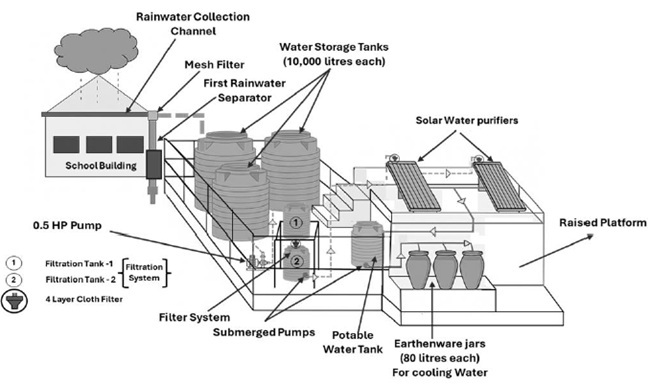
Fig.2: DWT line diagram
All the DWT components were tested and optimized in a pilot system set up at NARI before the school installations were carried out.
Results
Coliform estimation in water
Monitoring microbial contamination in water at various stages—storage tank, filtered water tank, and potable water tank is essential to ensure the safety and potability of drinking water. Multiple Tube Fermentation Technique7,8 was used for the assessment of coliform contamination of water. The primary source of water, which was rainwater was collected and stored in a rainwater storage tank at NARI.
A comparative analysis of the MPN (Most Probable Number) values of water from the rainwater storage tank and the filtered water tank demonstrated the significant reduction in microbial load following the first filtration stage in DWT (Fig. 3).
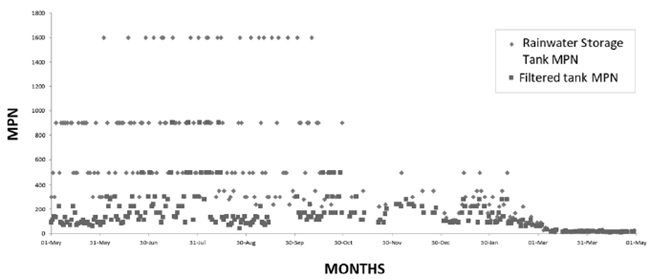
Fig.3: Comparative data of MPN values of water in rainwater storage tank
and filtered water tank (May 2024 to April 2025).
The yearly data of MPN values of water in different storage devices showed an average of 486 (monthly average range 41-837), 169 (monthly average range 32-287) and 0.68 (monthly average range 0-3.46) for rainwater storage tanks, filtered water tank and potable water tank, respectively. In an earlier study13 it was shown that all the coliforms were inactivated when water was filtered through a four-layered cotton cloth and heated either to 600 C for 15 min or 450 C for 3 hours.
On two days in 2024—July 25 and August 1 an MPN value of 90 per 100 ml potable water after it had passed through SWP unit was observed. On these days the water temperature in SWP unit remained below 450 C. During rest of the year the MPN count of potable water was zero (Fig. 4), with the 3:30 p.m. water temperature record confirming that it remained above 450 C for at least 3 hours. The solar water temperature readings at 3:30 pm were a good indicator of the temperature-time history of water (Fig. 5) and hence had a direct bearing on MPN count.
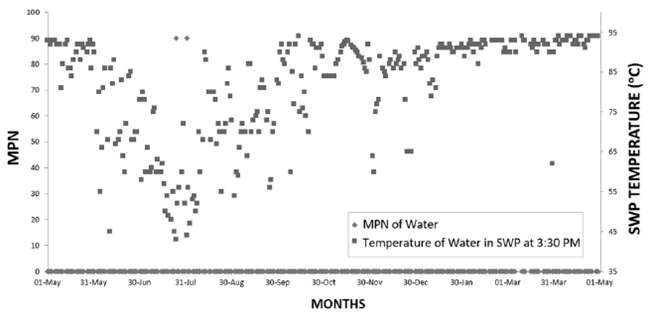
Fig.4: Month wise temperature of water in SWP unit at 3.30 pm
and corresponding MPN of potable water (May 2024 to April 2025).
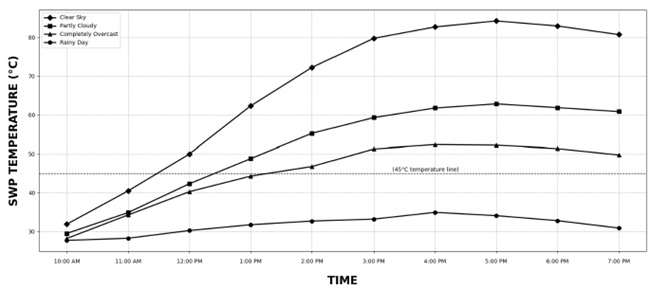
Fig 5. Representative of Temperature-Time history of SWP for varying sky conditions.
Comparison of water testing at NARI and external laboratory
Over the course of the year, the analysis of collected rainwater in LDPE tanks at NARI showed that the average Total Dissolved Solids (TDS) were < 25 mg/L, optical transmittance consistently reached 97%, and pH levels remained within the optimal range of 7.5 to 8.0. Also, the water had agreeable taste and odor. These values of physicochemical characteristics demonstrated that properly collected and stored rainwater meets potable water standards, requiring only appropriate purification for making it safe for consumption.
An independent assessment of SWP potable tank water quality was done by submitting samples to TUV India Pvt. Ltd., an NABL-accredited laboratory in Pune. The analysis was done in accordance with the Bureau of Indian Standards (BIS) specification IS 10500:2012 for drinking water. The laboratory's analysis confirmed that all tested parameters, viz. physical, chemical, and microbiological, were within the prescribed limits, indicating the water's suitability for human consumption. These findings also validated the results of our testing, reinforcing the reliability of our water quality assessment.
Thermal purification during hot days
There are many days, especially in the pre-monsoon season where the solar radiation and ambient temperatures are high. The temperature of water in SWP unit during these days reaches the threshold limit of 600 C within few hours. This allows purification of two batches per day thereby doubling the amount of water that can be purified by the same unit and reducing the purified water cost per liter. Fig. 6 shows the data of such an experiment.
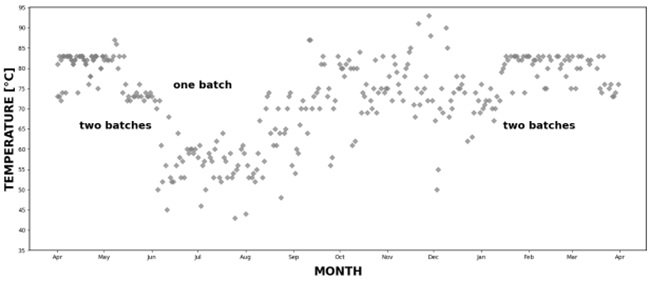
Fig.6: Month wise temperature of water in SWP unit at 1.30 pm (April 2024 to April 2025).
Implementation at Nandal and Adarki Schools
After the successful development of the DWT at NARI it was implemented in the two selected schools. The primary criteria for selecting these two schools were:
• Student Population:
Schools with around 200 students were prioritized, as the DWT was designed to effectively serve this number. Schools with classes up to the 10th standard were preferred, considering the ability of older students to responsibly operate and maintain the system.
• Availability of Drinking Water:
Schools without access to clean drinking water or with very limited water availability were selected to ensure maximum impact of the intervention. Based on these key criteria, Adarki Madhyamik Vidyalaya (200 students) and Shri Sant Dnyaneshwar Madhyamik Vidyalaya, Nandal (230 students) were selected. Both schools lacked clean drinking water and had poor water availability, especially during the pre-monsoon months, making them ideal candidates for DWT implementation.
RWH systems with integrated SWP units were installed at schools in Adarki and Nandal in Phaltan Taluka. Adarki is located around 26 km from NARI, while Nandal is situated 12.3 km away. To meet the daily potable water demand of 200 liters for school students, two 50 liters capacity SWP units were installed, operating in a dual-batch mode to maximize throughput. Fig. 7 shows the unit at Nandal School.
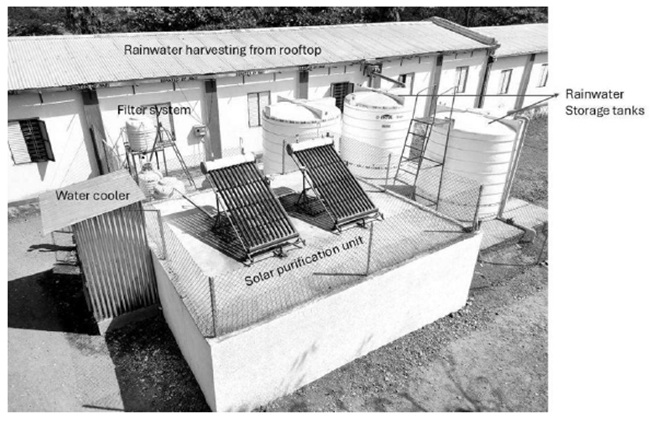
Fig.7: DWT system installed at Nandal High School.
This configuration yields 100 liters potable water per cycle, with two cycles conducted daily (total output: 200 l/day) during periods of adequate solar radiation (November–May). Fig. 8 shows that the temperature attained by the water in SWP unit at 3:30 pm was adequate to inactivate the coliforms in the water.
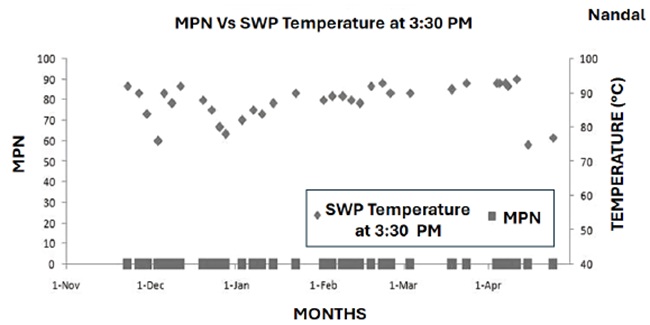
Fig.8: Nandal High School SWP unit MPN data (December 2024 to May 2025).
To ensure the effective implementation and sustainability of the Drinking Water Technology (DWT), training and orientation sessions were conducted for both staff and students at each beneficiary school. An instruction manual was written in simple English and later translated into Marathi to enable easy understanding, as one of the main aims of this project was to teach students about how DWT works so that they would get interested in STEM disciplines. A WhatsApp group was formed of the students and staff of the schools as well as NARI personnel engaged in the DWT work. This enabled easy monitoring of the status of the system as well as making it possible to get regular feedback regarding the temperature attained by the water in the SWP unit.
Economics
The capital cost of the DWT system (100 liters potable water/day) was approximately Rs. 3 lakhs, with scalability options to 200, 300, or 500 l/day (Table 2).
| Sr. No. | Item | Details |
| 1 | Assumptions | 1. RWH tanks make up 60% of the total capital cost. 2. Interest rate has been taken to be 12% p.a. 3. Loan repayment time is taken to be five years @ Rs. 60,000 per year. 4. Lifetime of the system is expected to be at least 10 years. |
| 2 |
Detailed Costing |
Cost (Rs.) Cost (%) 1. Storage tanks and their accessories 1.80,000 60 2. SWP units and their accessories 45.000 15 3. Balance of system 75,000 25 4. Total 3,00,000 100 |
Table 2: Costing of DWT system (100 l/day)
The major cost of the system (60%) is for rainwater storage tanks. If the cost of water tanks can be provided as a part of the Government of India school water mission, then for the first five years of a 10-year lifespan, the cost per liter of water is expected to be on an average Rs. 2.07 and then Rs. 0.65 per liter for the next five years. Therefore, the average cost of potable water for a 10-year life cycle will be Rs. 1.36 per liter.
Discussion
The DWT presented in this study is very simple, requires minimal maintenance, and is more user- friendly compared to other alternatives available in the market. Its characteristics which make it very useful are as follows:
Effective Water Purification: It significantly reduces microbial contamination and consistently produces safe drinking water that meets key quality standards for parameters such as MPN, TDS, pH, and transmittance.
Conclusion
The Drinking Water Technology (DWT) system has proven successful during its five-month operation in rural schools of western Maharashtra. Our monitoring of water quality demonstrated consistent compliance with WHO safety standards (0 MPN/100 ml), validating the system's technical reliability. This simple, sustainable system achieves two outcomes simultaneously: (1) reliable access to potable water, (2) active student engagement in water conservation through hands-on monitoring activities.
Through this publication we hope that this simple technology can spread and be used in various schools all over the country.
Acknowledgements
The authors thank the project team for implementing the drinking water technology (DWT) system successfully. We sincerely appreciate the hard work put into system installation, water quality testing, and on-site troubleshooting at the schools by Mr. Santosh Adsul (Technician) and Mr. Manoj Kumar (Research Fellow). We thank Mr. K. Krisnan (intern) for his help in preparing the figures. We also extend our sincere gratitude to the school principals, teaching and non- teaching staff and students whose support was crucial to the project's success.
References
1. NITI Aayog. (2019). Composite Water Management Index 2.0. Government of India. https://www.niti.gov.in/sites/default/files/2023 03/CompositeWaterManagementIndex.pdf(Page nos.: 143,156; Theme 7: Rural drinking water)
2. Maharashtra Water Resources Regulatory Authority. (2019). State Water Policy 2019. https://mwrra.maharashtra.gov.in/en/wp-content/uploads/sites/2/2022/09/State-Water Policy-2019.pdf (Page nos.: 3, 4[6.1, 6.2])
3. Sakthivel, S. R., Dhar, N. S., Godkhe, A., & Gore, G. (2015). Status of water supply in Maharashtra. Tata Institute of Social Sciences. (PDF) TISS KRC Study Report Status of Water Supply in Maharashtra (Page no.: 43)
4. World Health Organization. (2023, September 13). Drinking water. https://www.who.int/news-room/fact-sheets/detail/drinking-water (See part- Water and health, Economic and social effects)
5. Faroon, M. A., Al-Salihi, H. A., & Al-Salihi, R. A. (2023). Review on technology based on reverse osmosis. Anbar Journal of Engineering Sciences, 14(1), 89-97. https://ajes.uoanbar.edu.iq/ajes/article/view/582 (download the paper and see part-6. Reverse osmosis Disadvantages)
6. Li, W., Liu, E., and Belue, R. (2018). Household water treatment and the nutritional status of primary aged children in India: findings from the India human development survey. Globalization and Health, 14, Article number 37. https://globalizationandhealth.biomedcentral.com/articles/10.1186/s12992-018-0356 7
7. Bureau of Indian Standards (BIS). IS 1622:1981: Methods for sampling and microbiological examination of water [Reaffirmed 2021]. New Delhi: BIS; 1981. https://standardsbis.bsbedge.com/BIS_SearchStandard.aspx?Standard_Number =IS%201622&id =8189 (login required then you can download full protocol)
8. U.S. Environmental Protection Agency (1986) Method 9131: Total Coliform— Multiple Tube Fermentation Technique. https://www.epa.gov/sites/default/files/2015-12/documents/9131.pdf
9. World Health Organization. (2017) Potable Reuse: Guidance for Producing Safe Drinking-Water. https://iris.who.int/bitstream/handle/10665/258715/9789241512770 eng.pdf (Page no.: 34)
10. Patange, S. D., Nimbkar, N., & Rajvanshi, A. K. (2020). Low-cost drinking water technology – rainwater harvesting with solar purification. Current Science, 118(6), 872–876. https://doi.org/10.18520/cs/v118/i6/872-876
11. Unpublished. 2025. Report submitted to the funding agency.
12. Jacob, A., & Rajvanshi, A. K. (2006). Long term weather trends in Phaltan, Maharashtra. Nimbkar Agricultural Research Institute (NARI). Retrieved from https://nariphaltan.org/weather.pdf
13. Rajvanshi Anil K. & Rajvanshi Noorie (2018). Low-cost solar water purifier for rural households. https://www.currentscience.ac.in/Volumes/115/01/0032.pdf
14. Shivani Gupta (2025). With Saree & Solar Power, He’s Bringing Safe Drinking Water To 400+ Children in Rural Schools. https://thebetterindia.com/417624/dr-anil-rajvanshi-nari-maharashtra-rainwater-harvesting-drinking-water-to-children/
23-Aug-2025
More by : Dr. Anil Rajvanshi